Two Lessepsians Nudibranchs species, Tayuva lilacina [A. Gould, 1852] [Nudibranchia, Discodorididae] and Plocamopherus ocellatus Rüppell and Leuckart, 1828 [Polyceridae] and two Mediterranean Nudibranchs species Doris verrucoas [A. Gould, 1852] [Discodorididae] and Felimare picta [Philippi, 1836] [Chromodorididae] are reported for the first time in Latakia coastal water, and it is the first known occurrence of these four species in the Syrian Sea. The sea slugs were photographed in situ and identified in HIMR based on their species descriptions, Photographs and information available in global databases specialized in marine life.
Eastern Mediterranean; Mollusca; Non-Native Species; Nudibranchia; Opistobranchia; Rare Species; Sea Slugs
Nudibranchia are beautiful and colorful gastropod molluscs, they are well developed. Their shape, coloration, and decorations vary according to the diet and the habitat. They may be oval, elongated, thin, or flat, with or without dorsal tubercles or cerata, which vary in size and shape. Nudibrancehs inhabit Coralligenous habitats [5], they live in the coastal areas around the world, there isn't much data available on its diversity in the deep seas [25]. They are predators, feed on sponges, tunicates, sea anemones and many other benthic organisms [13].
Nudibranchs are very important indicators of warming seas, climate changes, pollution and loss of habitats, they respond very quickly to changes in the quality of the environment. Documenting their presence and diversity and monitoring their distribution in the region helps to understanding how ecosystems are changing [17]. Recent studies reveal the role of the Nudibrancehs in the biochemical cycle of some nutrients, in particular the silicate that accumulates in marine sponges, where the predation of these mollusks on the sponges contribute to deposition and recycling of sponges’ silica in high rates [15].
In relation to densities and number of local records, many species of sea slugs are still rare [29]. The number of recorded species of these sea slugs in the Mediterranean up to 2016 reached 270 [22], this number seems to be small compared to their diversity in the Indian Ocean and the Atlantic Ocean [11].
Many local and regional studies and researches confirm the increasing in number of alien nudibranchs in Mediterranean especially in the eastern part [26,18] indicate the contribution of climate changes and the rise of Mediterranean temperature in the settlement of many of them, their number reached 30 species until 2013, with a rate of 6% of the total number of sea slugs in the Mediterranean [8], although, in many studies carried out in the Mediterranean, samples of rare sea slugs species were obtained in several ways [10]. Most of them were sighted and photographed by divers whom shared these photos on websites and forums that specialized in sea slugs, such as the Mediterranean Slug Site and Sea Slug Forum, or by some experts around the world [37].
In Syria, the number of recorded species of nudibranchs until the year 2022 was only nine, one of which are native, one Cryptogenic and seven are aliens originating from the Red Sea, Indian and Pacific oceans. Two of these nine species had been mentioned in the list updated by Ammar in 2019 [2] then, four species were collected during the period 2020-2021 from small marina near Tartus and coastal pool north of Jableh, recorded for the first time at the Syrian coast [3]. Another species Calma glaucoides [26] was recorded in 1995 at Afamia coast in Latakia [1], Bursatella leachii Blainville, 1817 was mentioned that it was found at the Syrian coast, but we couldn't confirm that. Spurilla neapolitana has been recorded for the third time in the eastern Mediterranean after it was recorded in Turkey [22] and Greece [16].
This article shows the taxonomic status of additional two rare Lessepsians and two rare Mediterranean nudibranch species which were recently observed by an amateur diver, and introduce some of their biological characteristics and new ecological data on the Syrian coast for the first time.
One specimen of each of the four species of nudubranches was sighted in the shallow water at Ibn Hani site [North of Latakia] [Figure 1A] and Al-Samraa site [Figure 1B], between 2019 – 2022 by free diving at a depths ranging between [2-7m]. It has been photographed in the sites by Nouh Abbass. The specimens were classified and described according to [38,36,24]. Nomenclature follows WoRMS Editorial Board [2023] [35].
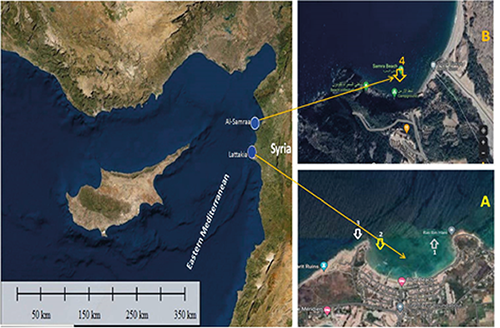
Figure 1: Survey areas at the Syrian coast: A: Ibn – Hani area where the three nudibranch species (1, 2, 3) were found, B: Shatt al-Armen area where the Felimare picta (4) was found.
Below we demonstrate the taxonomic status, global distribution, and the most important morphological and environmental characteristics of the four rare species that were sighted for the first time in the Syrian coast.
1-Tayuva lilacina [Gould, 1852]
Classification
Mollusca [Phylum], Gastropoda [Class], Heterobranchia [Subclass], Nudibranchia [Order], Discodorididae [Family], Tayuva [Genus], Tayuva lilacina [Species].
This species is widespread in the tropical and subtropical Indo-Pacific, from the Red Sea to Hawaii. It is present in European waters [12,30], Indonesia, Cuba, Cape Verde, the North Atlantic, the western Mediterranean, the Aegean Sea, and the eastern Mediterranean [35].
The body is oval and flat, covered with a mantle extending to the posterior end of the mollusk, with many small tubercles on the dorsal side, which are larger in the middle of the body. The head is adorned with two pairs of small tentacles.
One individual was sighted on 25 September 2022, at the Ibn Hani site [35.592939, 35.750071], at a depth of approximately two meters. The size of this mollusk was about 30-40 mm, this individual appears small compared to the common size of this species, which ranges between 60-70mm [38].
Color: The animal's color is dull grayish-brown in general, with several round or oval dark brown spots of various sizes, which are larger in the central region of the dorsum. Pigmentation varies from one individual to another, according to what is indicated by the pictures of this species in the Sea slug forum and the World register of marine species. The Syrian specimen is pale gray and dotted with dark brown spots and/or like-spots, of small and large size, irregular in shape, distributed randomly throughout the dorsum of the mollusk, small brown spots are observed at the edges of the mantle [Figure 2]. This sample picture is distinguished from the rest of the pictures in specialized sites.
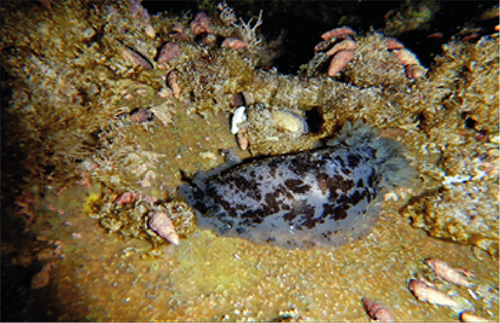
Figure 2: Discodoris lilacina (Gould, 1852) from the Syrian coast.
This species lives in intertidal zone and shallow areas in the Indian and Pacific Oceans [38] and under dead coral slabs. It is a non-native species in the Mediterranean Sea, likely to have arrived via the Suez Canal. Its presence is rare in the Levantine basin, where only two individuals were found, noting that it was recorded for the first time in 1974 [6] in dredged samples collected from a depth of 40m, and for the second time in 2002 when one specimen was found in Lebanon at a rocky bottom at a depth of 2-3m [34].
2-Plocamopherus ocellatus Rüppell and Leuckart, 1828
Classification
Mollusca [Phylum], Gastropoda [Class], Heterobranchia [Subclass], Nudibranchia [Order], Polyceridae [Family], Plocamopherus [Genus], Plocamopherus ocellatus [Species] [35].
This species is a Lessepsian migrant that arrived in the eastern Mediterranean through the Suez Canal. It is a rare species, even in its native western Indian Ocean [14], spreading in the Red Sea and Suez Canal [Rüppell and Leuckart, 1828-1830], north Atlantic, and the eastern Mediterranean including the Levantine basin. This species was described in the SEISM atlas in 2003, and all its general and distinguished characteristics were mentioned as an alien species in the Mediterranean Sea [38].
The studied sample: one individual, small in size not exceeding a 40mm, colored as it appears in the captured picture in a brown color with many yellow-orange spots irregular in its shape [Figure 3], the body is elongated, the foot extends beyond the end of the dorsum, and the small papillae located on the edge of the mantle is forked and clear. The gills consist five triangular gill leaflets. It differs and is distinguished by its color from the description given for the rest of the samples, which were mentioned to be colored with spots and marks that look like eyes tending to red with a black background. This individual was observed swimming in the water column, to settle after that on the rocky bottom, at a depth of 5-6m in Ibn Hani, north of Latakia [35.591589, 35.743336] at 14 July 2022. It is the first record of this alien mollusk in the Syrian Sea,
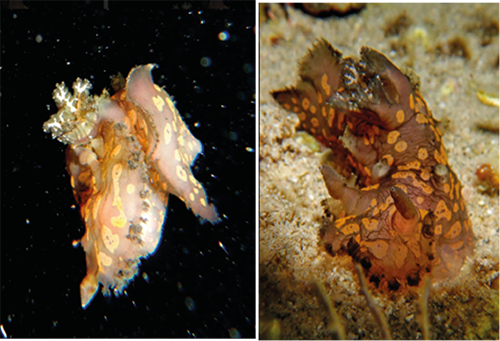
Figure 3: Plocamopherus ocellatus specimen from the Syrian coast. A: Plocamopherus ocellatusis in the water column, B: Plocamopherus ocellatus settles on the rocky bottom.
Plocamopherus ocellatus appears to be rare in Mediterranean, as the number of known records since 2005 is 20 [9], before that, only 5 specimens were found in the Levantine basin from 1977-2003 [34]. It has been recorded in the neighbor’s countries at different depths that limited to 50m [22,8,7,25,16]. It was also recorded in Greece [23] and European waters in the north Atlantic Ocean [12].
3-Doris verrucosa Linnaeus, 1758
Classification
Mollusca [Phylum], Gastropoda [Class], Heterobranchia [Subclass], Nudibranchia [Order], Dorididae [Family], Doris [Genus], Doris verrucosa [Species] [19].
One individual, about 15mm long, at a depth of about 7m, was sighted under stone on hard bottom associated with calcareous sponges that form its food [24] on 19, July 2022 at Ibn Hani site near the Higher Institute for Marine Research [35.593043, 35.741230].
The body appears covered with numerous and large papillae, a pair of short antennae on the head, the gills are pinnate and long, they are 10-18 in a circular arrangement, there are warts on the margin of the rhinophore and the gills, the observed specimen is colored in a yellowish-gray, as shown in figure 4.
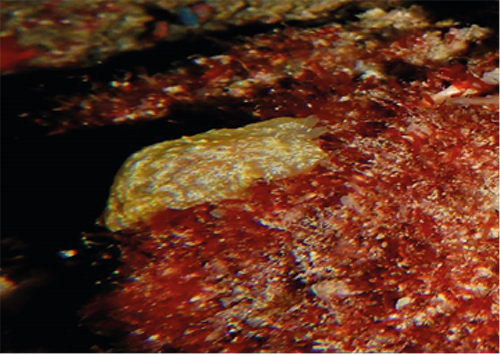
Figure 4: Doris verrucosa from the Syrian coast.
It is the first record of this sea slug on the Syrian coast, although a review of the data available in the World Register of Marine Species [35] indicates that this species is widespread throughout the Mediterranean and some shores of the Atlantic Ocean: Cape Verde, South Africa, South Atlantic Ocean, Caribbean Sea, Costa Rica, Gulf of Mexico, North Atlantic Ocean [The Zoological Record], it was recently recorded in Tunisia for the first time in 2017 [4], and there are no recent records of it in the rest of the Mediterranean. This confirms the rarity of this species or perhaps the difficulty of noticing it in its presence areas due to its white color and small size, this also emphasize the role of divers, non-researcher amateurs and non-biologists in revealing the presence of more of rare species in the marine environment.
4-Felimare picta [Philippi, 1836]
Classification
Mollusca [Phylum], Gastropoda [Class], Heterobranchia [Subclass], Nudibranchia [Order], Chromodorididae [Family], Felimare [Genus], Felimare picta [Species] [MolluscaBase, 2023].
This species has a global distribution, in the Western Atlantic, the Caribbean, the Eastern Atlantic and the Mediterranean Sea [35]. It is characterized by its variety of colors and different patterns of coloration. Many classifiers put it under many subspecies [20,33]
A single individual was sighted during a free diving, lying on the rocky sea beds [Figure. 5] on Jun 2019, at Shatt al-Armen area [35.927828, 35.915995] [Figure 1B] at 5m depth.
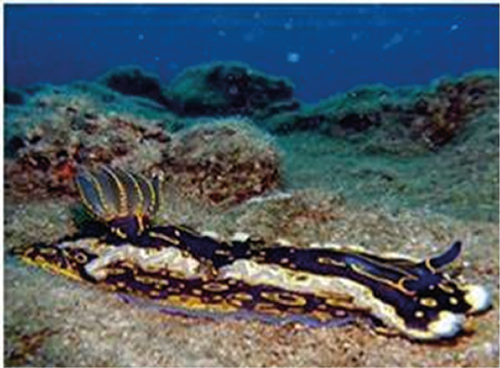
Figure 5: Felimare picta from the Syrian coast.
This specimen appears to be the largest at all with the size of 18cm. It has special pattern of coloration in compared to photos from other regions of the Atlantic and the Mediterranean [27], it is characterized with dark background and parallel continues yellow lines on the dorsum which reach the rhinophoral sheaths and completed yellow circles around the edge of the rhinophoral sheath and continue forward, mantle margin is surrounded by a white area. Many yellow rings on the edges.
Thus, the current work adds two non-native species of sea slugs and another two native to the previously recorded species in the Syrian coast, namely: six species of Indian origin and the Red Sea, these species are: Goniobranchus annulatus [Eliot, 1904], Goniobranchus obsoletus [Rüppell and Leuckart, 1830], Elysia grandifolia Kelaart, 1858,Elysia ornata [Swainson, 1840], Hypselodoris infucata [Rüppell and Leuckart, 1830] and Bursatella leachii Blainville, 1817, in addition to Thecacera pennigera [Montagu, 1813] as a Cryptogenic species, Spurilla neapolitana [Delle Chiaje, 1823] and Calma glaucoides [26] are an Atlantic species.
Most of these species live on rocky substrates in the shallow coastal area up to 10m depth. Thecacera pennigera [Montagu, 1813], was collected from the muddy bottom at 100m depth [2]. Elysia grandifolia was the most abundant, the other species were rare since they didn't exceed two records and its specimens were not more than three. Hypselodoris infucata was reported to be invasive species in the Mediterranean, but in Syria it is still available in few numbers.
The increase in the number of non-native species recorded in Syria and the eastern Mediterranean confirms the continued flow of Lessepsian species from the Red Sea through Suez Canal, and supports the idea that global warming contribute allowing these species to settle and dominate. In light of the current procedures in Syria, which prevent scuba diving, we emphasize the role of amateur free divers in detecting the existence of more species, and we point out the contribution of social media in drawing attention to the state of alien species in Syria, and increasing interest of young researchers and even fishermen who began publishing pictures of these species on Facebook and Instagram, which may contribute revealing the existence of more aliens and rare species.
- Ammar, I. (1995) Quantitative and Qualitative Study of Zoobenthos in Lattakia Coast. Master Thesis 173.
- Ammar I A (2019) Updated List of Alien Macrozoobenthic Species Along the Syrian Coast. International Journal of Aquatic Biology 7: 180-194.
- Ammar, I.A., Khalifa F, Mhanna, H., Halal M (2022) First Record of Four Species of Nudibranchia Molluscs from Chromodorididae and Plakobranchidae Families in Syria. Species 23: 14-19.
- Antit, M., Kalthoumi, D., Pola, M., Urra, J. and Azzouna A (2018) First Record of Doris Verrucosa Linnaeus, 1758 (Mollusca: Heterobranchia: Nudibranchia) in the Bay of Tunis, Tunisia (Central Mediterranean). In: Kallel, A., Ksibi, M., Ben Dhia, H., Khélifi, N. (eds) Recent Advances in Environmental Science from the Euro-Mediterranean and Surrounding Regions. EMCEI 2017. Advances in Science, Technology & Innovation. Springer.
- Ballesteros E (2006). Mediterranean Coralligenous Assemblages: a Synthesis of Present Knowledge. Oceanography and Marine Biology: An Annual Review44: 123-195.
- Barash, A. and Danin Z (1977) Additions to the knowledge of Indo-Pacific Mollusca in the Mediterranean. Conchiglia13: 85-116.
- Crocetta, F., Agius, D., Balistreri, P., Bariche, M., Bayhan, Y., et al. (2015) New Mediterranean Biodiversity Records (October 2015). Mediterranean Marine Science 16: 682.
- Crocetta, F., Zibrowius, H., Bitar, G., Templado, J. and Oliverio, M. (2013) Biogeographical Homogeneity in the Eastern Mediterranean Sea - I: The Opisthobranchs (Mollusca: Gastropoda) from Lebanon. Mediterranean Marine Science 14: 403.
- Fernandez-Vilert, R., Gimenez, J., Mas, G., Figueroa, I., Moles J (2018) First records of the Red Sea Alien Mollusk Haminoea Cyanomarginata (Gastropoda: Heterobranchia: Cephalaspidea) in the Western Mediterranean. Journal of Natural History 52: 1817-1823.
- Follett, R., Strezov V (2015) An Analysis of Citizen Science Based Research: Usage and Publication Patterns. PLoS One 10. [Crossref].
- Furfaro, G., Mariottini, P (2016) Check-list of the Nudibranchs (Mollusca Gastropoda) from the Biodiversity Hot Spot "Scoglio Del Corallo" (Argentario promontory, Tuscany). Biodiversity Journal 7: 67-78.
- Gofas, S., Le Renard, J. and Bouchet, P., Mollusca in: Costello, M.J. et al. (2001) European Register of Marine Species: A Check-list of the Marine Species in Europe and a Bibliography of Guides to their Identification. Patrimoines Naturels 50: 180 - 213.
- Gutiérrez M.C., Ortea J., Rivero N., Tucker G.C., Malaquias M.A.E et al. (2015) The Opisthobranch Gastropods (Mollusca: Heterobranchia) from Venezuela: An Annotated And Illustrated Inventory of Species Zootaxa 2: 201-256.[Crossref].
- Hoeksema, B.W., Yonow N (2021) Rarity in the Native Range of the Lessepsian Migrant Plocamopherus Ocellatus (Nudibranchia): Fact or Artifact? Ecology 102. [Crossref].
- López-Acosta, M., Potel, C., Gallinari, M., Pérez, F., Leynaert A (2022) Nudibranch Predation Boosts Sponge Silicon Cycling. Scientific reports.
- Manousis T (2021) The Marine Mollusca of Greece: an up-to-date, Systematic Catalogue, Documented with Bibliographic and Pictorial References. Xenophora Taxonomy34: 26-47.
- Mehrotra, R., Arnold, S., Wang, A., Chavanich, S., Rüppell, B., et al. (2020) A New Species of Coral-Feeding Nudibranch (Mollusca: Gastropoda) From The Gulf of Thailand. Marine Biodiversity 50: 36.
- Mioni, E., Furfaro G (2022) Alien Travel Companies: The Case of Two Sea Slugs and One Bryozoan in the Mediterranean Sea. Diversity 14: 687.
- MolluscaBase E D S. (2023). MolluscaBase Doris Verrucosa Linnaeus, 1758. World Register of Marine Species.
- Ortea, J., Valdés, A., García-Gómez JC (1996) Revisión de las e Species Atlánticas De La Familia Chromodorididae (Mollusca: Nudibranchia) de grupo cromático azul. [Review of the Atlantic Species of the Family Chromodorididae [Mollusca: Nudibranchia] of the Blue Chromatic Group.] Avicennia 1: 1-165.
- Oskars, T.R., Bouchet, P., Malaquias M A E (2015) A New Phylogeny Of The Cephalaspidea (Gastropoda: Heterobranchia) Based on Expanded Taxon Sampling and Gene Markers. Mol PhylogenetEvol 89: 130-150. [Crossref].
- Öztürk, B., Doğan A., Bitlis-Bakir, B., Salman A (2014) Marine Molluscs of the Turkish Coasts: An Updated Checklist. Turkish Journal of Zoology 38: 832-879.
- Ragkousis, M., Abdelali, N., Azzurro, E., Badreddine, A., Bariche M et al. (2020) New Alien Mediterranean Biodiversity Records (October 2020). Mediterranean Marine Science 21: 631-652.
- Riedl R (2011) Fauna nd Flora des Mittelmeeres 'Fauna and Flora of the Mediterranean'. Wien: Seifer Verlag GmbaH.
- Rothman, S., Galil B (2015) Not So Rare: Plocamopherus Ocellatus (Nudibranchia, Polyceridae) in the Eastern Mediterranean. Marine Biodiversity Records, 8: 144.
- Rothman, S B S., Mienis, H K., Galil B S (2017) Alien Facelinid Nudibranchs in The Eastern Mediterranean: First Report of Phidiana Militaris (Alder and Hancock, 1864) And Report of Caloria Indica (Bergh, 1896) 30 years after its Previous Sighting. BioInvasions Records, 6: 125-128.
- Rudman W B (2000) Hypselodoris picta (Schultz, 1836). Sea Slug Forum.
- Rüppell, E. Mollusca; Neue wirbellose Thiere des rothen Meers. Frankfurt am Main 12: 15-47.
- Schubert, J., Smith, S D A (2020) Sea Slugs— “Rare in Space and Time”—but not always Diversity 12: 423.
- Streftaris, N., Zenetos, A., Papathanassiou E (2005) Globalisation in Marine Ecosystems: The Story of Non-Indigenous Marine Species Across European Seas. Oceanography and Marine Biology: An Annual Review. 43: 419-453.
- Templado J (2002) Indo-Pacific Doridnudibranchs Collected in Lebanon (Mediterranean Sea). Iberus 20: 23-30.
- The Zoological Record: Records of Zoological Literature Relating Chiefly to The Year. Zoological Society of London City.
- Troncoso, J.S., Garcia, F.J., Urgorri V (1998) Anatomical Data on Rare Hypselodoris Picta (Schultz, 1836) (Gastropoda, Doridacea) From the Coast of Brazil with Description of a New Subspecies. Bulletin of Marine Science 63: 133-141.
- Valdés, A., Templado J (2002) Indo-Pacific Doridnudibranchs Collected in Lebanon (Mediterranean Sea). Iberus 20: 23-30.
- WoRMS Editorial Board (2023). World Register of Marine Species.
- Yonow N (2008) Sea Slugs of the ed sea. Pensoft Publishers.
- Yonow, N. (2015) Sea Slugs: Unexpected Biodiversity and Distribution. In: Rasul, N., Stewart, I. (eds) The Red Sea.
- Zenetos, A., Gofas, S., Russo, G., Templado J (2003) CIESM Atlas of Exotic Species in the Mediterranean. Molluscs. (F. Briand ed.), Monaco: CIESM publishers 3: 367. Ballesteros





